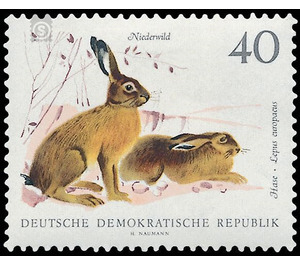small game - Germany / German Democratic Republic 1968 - 40 Pfennig
Theme: Animals
| Country | Germany / German Democratic Republic |
| Issue Date | 1968 |
| Face Value | 40.00 |
| Color | multi-colored |
| Perforation | K 13 1/2: 13 |
| Printing Type | offset |
| Stamp Type | Postage stamp |
| Item Type | Stamp |
| Chronological Issue Number | 1104 |
| Chronological Chapter | GER-DDR |
| SID | 811192 |
| In 9 Wishlists | |
Small game The Ministry of Posts and Telecommunications of the German Democratic Republic announces six multi-colored commemorative stamps for the "Year of the Small Game 1968", which is to increase the number of small game stocks. The stimulus for this special stamp series was given by the State Committee for Forestry at the Agricultural Council of the GDR. Small game Six special postage stamps and a first day envelope bring the philatelists close to hunting animals. A special cancel complements this issue with designs of small game. The most well-known is the hare (Lepus europaeus Pallas) pictured on the 40-pfennig value. It is a valuable species of small game, which is gradually spread by exposure almost all over the world. The German Democratic Republic also exports live rabbits. The hare has been native to us for many millennia (since the early Tertiary), hence a popular animal form (Löffelmann, Mümmelmann, Easter Bunny). He is very adaptable, but predominantly a field dweller. In pure arable areas, such as the Magdeburger Börde, there is therefore the largest game density. The sexes do not differ in size and color. The Häsin sets 3 to 4 times a year on average 1 to 4 young hares, in total about 6 to 10 young hares a year. These are already hairy, looking and able to move, and they already have teeth. The food consists of green parts of plants, young shoots of woody plants and barks. The hare is true to the location and stays in the vicinity of the place where it was set. He is rarely seen during the day, so he is more of a night animal. Adult hares have an average weight of 4 to 5 kg.


